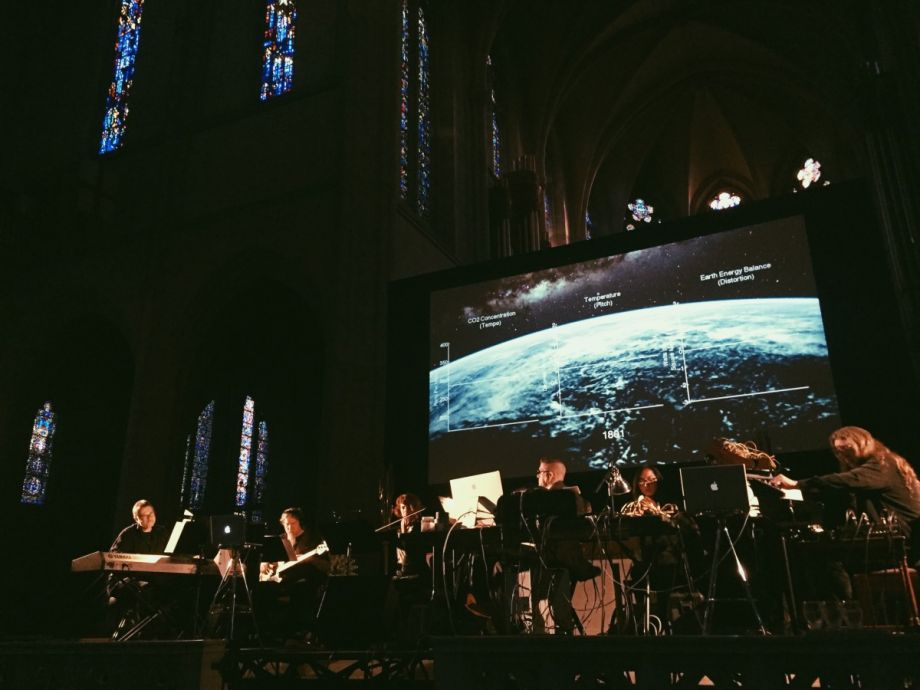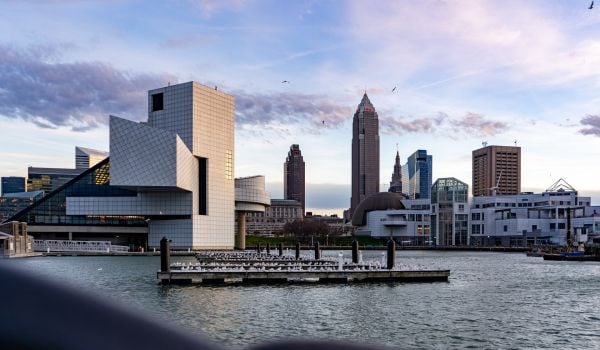Climate scientists know this hard truth better than anyone: You can give the people data, but you can’t make them care.
That’s been one of the problems in the climate change movement from the start.
There’s never been a lack of scientific evidence — especially with the release of the latest Intergovernmental Panel on Climate Change report — of humans’ impact on the climate. Nor is there a lack of scientifically backed solutions to slow climate change to livable levels. But that information hasn’t hit enough people hard enough to make us demand swift action from the companies and governments who have the power to address the issue at the necessary scale.
So while the idea of scientists collaborating with musicians to create climate science-inspired music may initially sound surprising, it’s actually a very logical approach to solving a pernicious problem. If science doesn’t move people to action, maybe music will.
This is the idea behind ClimateMusic, a San Francisco-based organization founded by artist, musician, and former public servant Stephen Crawford. Today, he runs ClimateMusic full-time along with his fellow executive team members: Laurie Goldman, a public policy professional and former deputy director of UC Berkeley’s Global Engagement Office, and Fran Schulberg, an international environmental policy attorney and former fellow at the Council on Foreign Relations.
“My career has been entirely about international environmental action,” says Schulberg. “And one of the frustrations has always been that all the information has been available for a long time — but how do you jolt people into action? Those of us in the field, we talk to each other a lot, but we’re not necessarily reaching the audiences who aren’t otherwise engaged in this issue. Music is a fascinating approach to doing that.”
Schulberg has been with ClimateMusic from its beginnings in 2017, when Crawford, whom Schulberg knew when they were colleagues at a previous job, approached her with the idea of using music to ignite action on climate change.
“We said ‘Let’s try it out,’” Schulberg says. “So we organized a one-day event. We got a group of scientists and musicians together in a room from 8 a.m.– 5 p.m. — we brought in food, drinks, everything. Just to see whether scientists and musicians working together could create something that had an emotional impact on people. And it worked.”
By “working,” Schulberg means a couple of things. The first is that scientists and musicians could indeed collaborate to create art that translated scientific information into music. The organization has never had to struggle to find scientists who were interested and willing to enter into this kind of unorthodox partnership.
One of those, internationally renowned climate expert and ClimateMusic’s lead science advisor Dr. William Collins, explains why. “Those of us in the climate sciences are utilizing all available channels to get the word out about the urgency of and opportunities for constructive environmental solutions. We know we need to still message the facts and figures, but also reach hearts and minds through music, visual arts, the spoken word, and social media. As the IPCC has made clear, it’s all hands on deck time.”
The second is that when the resulting piece by composer Erik Ian Walker, “Climate,” was performed, the music did what it was intended to do: change people’s minds and inspire them to action.
Schulberg and the ClimateMusic team know this because it’s exactly what they’ve heard from audiences, as well as the scientists whom they work with.
“One of the scientists we work with has given hundreds of lectures on climate change, and he told us that no one had ever come up to him after a lecture and said, ‘This really changed my perspective.’ But after these performances, audience members do approach him and say, ‘This changed my perspective, and I’m going to change my behavior,’” she says. “You have this visceral reaction to the music that’s different than if you read about the issue, or you go to a lecture. It’s reaching people through their hearts and minds.”
Today, ClimateMusic has three original pieces in their portfolio, each of which was created in collaboration with The ClimateMusic Project scientists: “Climate” by the aforementioned Walker, “Icarus in Flight” by Richard Festinger, and “What If We” by Wendy Loomis, which includes a spoken word component.
These pieces all include a visual component showing graphs or other depictions of climate data to help illustrate the musical experience.
Each musical piece is developed differently depending on the approach that the composer wants to take, but one thing they all share is that they are more than simply “inspired by” climate change.
In “Climate,” which deals with some of the chemical implications of climate change, four key indicators are each represented by a different musical analog.
CO2 concentration is represented by the music’s tempo; near Earth atmospheric temperature is equated to pitch; the Earth energy balance (balance between incoming energy from the sun and outgoing energy from Earth) is represented by distortion and volume; and ocean pH by the compositional form. As the pH drops, becoming more acidic, the compositional form of the piece begins to fall apart.
ClimateMusic Project composers have also used the sonification approach within their pieces, using computer programs that translate data into sound.
At performances, there’s a certain format that’s been successful. First, the pieces are introduced by a ClimateMusic Project scientist. Then afterward, there’s an opportunity for audience engagement with a scientist, a musician, and often someone from one of the action organizations that ClimateMusic partners with. These include the environmental group SF Environment, the renewable energy organization Re-Volv, and the religious climate change organization California Interfaith Power and Light, among others.
“We’re not an action organization ourselves, but we’re growing that pathway for audience members to take action through one of those partners,” Schulberg says. In addition to gathering the extensive anecdotal feedback they’ve gotten from audience members, the ClimateMusic team is working on ways to capture more data about the actions that result from their performances.
Since its founding in 2017, ClimateMusic has hosted around 40 live events total, including virtual and in-person. Recently, they hosted a virtual event with the National Academy of Sciences for the 50th anniversary of Earth Day, which featured clips of “Icarus in Flight” and a discussion of the music and science behind it.
This fall, the organization has planned its most ambitious concert yet, assuming that the COVID situation doesn’t alter their plans.
On Nov. 12, ClimateMusic will host a two-city, integrated concert featuring live performers and audiences in Vienna, Austria and San Francisco. “This is unlike anything we’ve done before, and we’re hoping to reach a global audience,” says Schulberg.
The combination of music and science has proven to be a winning one — in fact, the organization currently has five more musical pieces in the works. “It’s been interesting to see how many scientists have the soul of an artist,” Schulberg says. “They like to get involved in the creative effort.”

Elizabeth Pandolfi is a freelance arts and culture journalist. She is the former arts editor of the Charleston City Paper, and her work has appeared in Art and Antiques magazine, Charleston magazine, WNC magazine, and other publications.
















